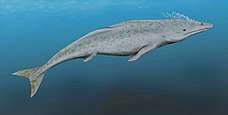Protocetus
Protocetus atavus ("first whale") is an extinct species of primitive cetacean from Egypt. It lived during the middle Eocene period 45 million years ago.
| Protocetus | |
|---|---|
 | |
| Underside of a skull cast at the Museum für Naturkunde, Berlin | |
| Scientific classification | |
| Kingdom: | Animalia |
| Phylum: | Chordata |
| Class: | Mammalia |
| Order: | Artiodactyla |
| Infraorder: | Cetacea |
| Family: | †Protocetidae |
| Genus: | Protocetus |
| Species: | P. atavus |
| Binomial name | |
| Protocetus atavus | |
The first discovered protocetid, Protocetus atavus was described by Fraas 1904 based on a cranium and a number of associated vertebrae and ribs found in middle Lutetian Tethyan marine limestone from Gebel Mokattam near Cairo, Egypt.[1]
Description

Protocetus had a streamlined, whale-like body around 2.5 metres (8.2 ft) long, but was relatively primitive in many respects; it still had small hind flippers, and its front flippers had webbed toes. Its jaws were long and lined with deadly teeth. The shape of the bones in the tails suggests that it may have evolved tail flukes, like those of modern whales, and, while it did not have a true blowhole, the nostrils had already begun to move backwards on the head.[2]
Unlike its more primitive predecessor Pakicetus, the structure of the ears suggests that Protocetus was able to hear properly underwater, although it is unlikely that it could echolocate. Similarly, it retained sufficient olfactory apparatus to have a good sense of smell, although it probably relied more on its eyesight to find prey.[2]
See also
| Wikimedia Commons has media related to Protocetus. |
| Wikispecies has information related to Protocetus |
References
Notes
- Bianucci & Gingerich 2011, p. 1174
- Palmer, D., ed. (1999). The Marshall Illustrated Encyclopedia of Dinosaurs and Prehistoric Animals. London: Marshall Editions. p. 230. ISBN 978-1-84028-152-1.
Sources
- Fraas, Eberhard (1904). "Neue Zeuglodonten aus dem unteren Mitteleocän vom Mokattam bei Cairo". Geologische und Paläontologische Abhandlungen. 6 (3): 199–220. Retrieved July 2013. Check date values in:
|accessdate=(help)CS1 maint: ref=harv (link) - Bianucci, Giovanni; Gingerich, Philip D. (2011). "Aegyptocetus tarfa, n. gen. et sp. (Mammalia, Cetacea), from the middle Eocene of Egypt: clinorhynchy, olfaction, and hearing in a protocetid whale". Journal of Vertebrate Paleontology. 31 (6): 1173–1188. doi:10.1080/02724634.2011.607985.CS1 maint: ref=harv (link)